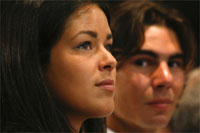Roland Garros 2009
The tournament before the tournament
by Paul Myers
Article published on the 2009-05-24 Latest update 2009-05-24 11:38 TU
The 31-year-old Argentine Guillermo Canas, ranked eighth in the world four years ago, but outside the top 100 at the start of the month, was felled in the first round of qualifiers by the 27-year-old Italian Paolo Lorenzi, whose best year, 2006, saw him reach 168 in the world.
The 31-year-old Slovakian Dominik Hrbaty fared only slightly better. A semi-finalist at the 1999 tournament, he got to the third round of the qualifying event before losing in straight sets to the Czech player Jiri Vanek, himself an 11-year veteran of the ATP circuit .
While the Czech journeyman won that particular eastern European clash earlier in the afternoon, as the shadows drew in the home crowds packed Court 6 to will on Sebastian de Chaunac against Daniel Brands.
It was a battle royal between the 31-year-old Frenchman and the German who was ten years his junior.
After three hours and 57 minutes, it was the German who emerged victorious: 10-8 in the deciding third set.
The match statistics show the narrow margins. De Chaunac won a total of 156 points; Brands 158. Two points the difference between the thrill of the main draw or the damp towel of consolation.
The ledge between glory and failure is no less precarious for the women, and Elena Bovina epitomises the highs and lows of the game. At the turn of the century she was in the vanguard of Russians who were starting to dominate the women’s circuit.
In 2003 the then 20-year-old Muscovite was just outside the top 20, and the following year she was knocking on the door of the top ten.
But since 2005, shoulder injuries have hampered her progress, and she slumped on Wednesday to a 6-2 6-1 first qualifying round defeat to the German Tatjana Malek, who has never even played in the main event at Roland Garros.
Malek eventually went out to the 26-year-old Austrian Yvonne Meusburger who, thanks to the win, reached the first round of the main event for the third consecutive year.
That kind of consistency is what Channelle Scheepers says she’s aiming for. The 25-year-old South African stepped off Court 8 on Friday afternoon, following her 6-3 6-1 win over the German Kathrin Woerle, elated that she had made her second grand slam main draw of the year.
“Every time you do it you just feel as if all the hard work has paid off,” she said.
Even though the latter stages of a major are a foreign territory to her, Scheepers still spoke like a seasoned veteran when asked about her ambitions for the subsequent matches.
“I think just take every match as it comes. Obviously you want to do well. It’s not just to qualify but to do well in the main draw. Ultimately I hopefully won’t have to qualify for the other grand slams if I can keep going, doing well so that I can get my ranking up.”
While Scheepers slipped off court unheralded - save for the dozen or so flag-waving South Africans - the progress of Michelle Larcher de Brito was, by contrast, drenched in limelight. She has come through the qualifiers and is into the main draw of a grand slam for the first time. Just 16 years old, the Lisbon-born wunderkind is eventually expected to be more than cannon fodder for the seeds.
De Brito may well cause a few ripples in her first Roland Garros. She certainly has the credentials. She was at the Nick Bollettieri tennis academy in Bradenton, Florida, from the age of nine until she turned professional two years ago. She has been billed as the new Maria Sharapova, and if she can emulate the on court pyrotechnics of that particular Bollettieri academy graduate, she'll give Portugal its first winner of a grand slam tennis title.






